Management Accounting Report: Financial Analysis of AFC Energy PLC
VerifiedAdded on 2020/11/23
|20
|5553
|392
Report
AI Summary
This management accounting report analyzes the financial aspects of AFC Energy PLC, a developer of alkaline fuel cells. It begins by explaining different management accounting systems, including cost accounting, inventory management, and job costing, and their essential requirements. The report then details various management accounting reporting methods, such as performance reports, cost managerial accounting reports, budget reports, and accounts receivable aging reports. It also outlines the benefits of applying these systems within an organization. The core of the report includes a cost calculation using marginal costing. Furthermore, the report explores budgetary concepts, planning tools, and their advantages and disadvantages in budgetary control. Finally, it examines how management accounting systems can be adapted to solve financial problems, concluding with a comprehensive overview of the company's financial strategies.
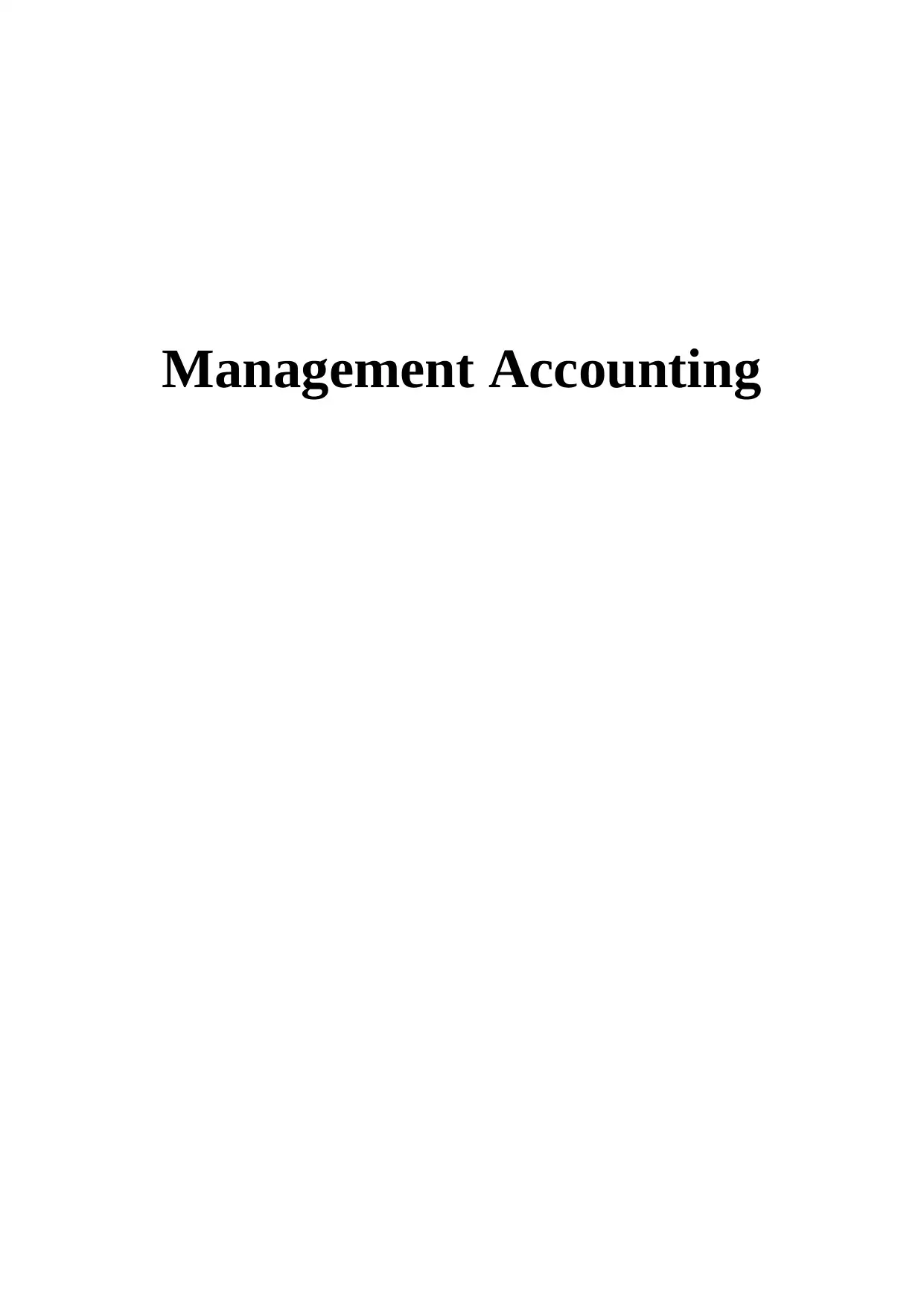
Management Accounting
Paraphrase This Document
Need a fresh take? Get an instant paraphrase of this document with our AI Paraphraser
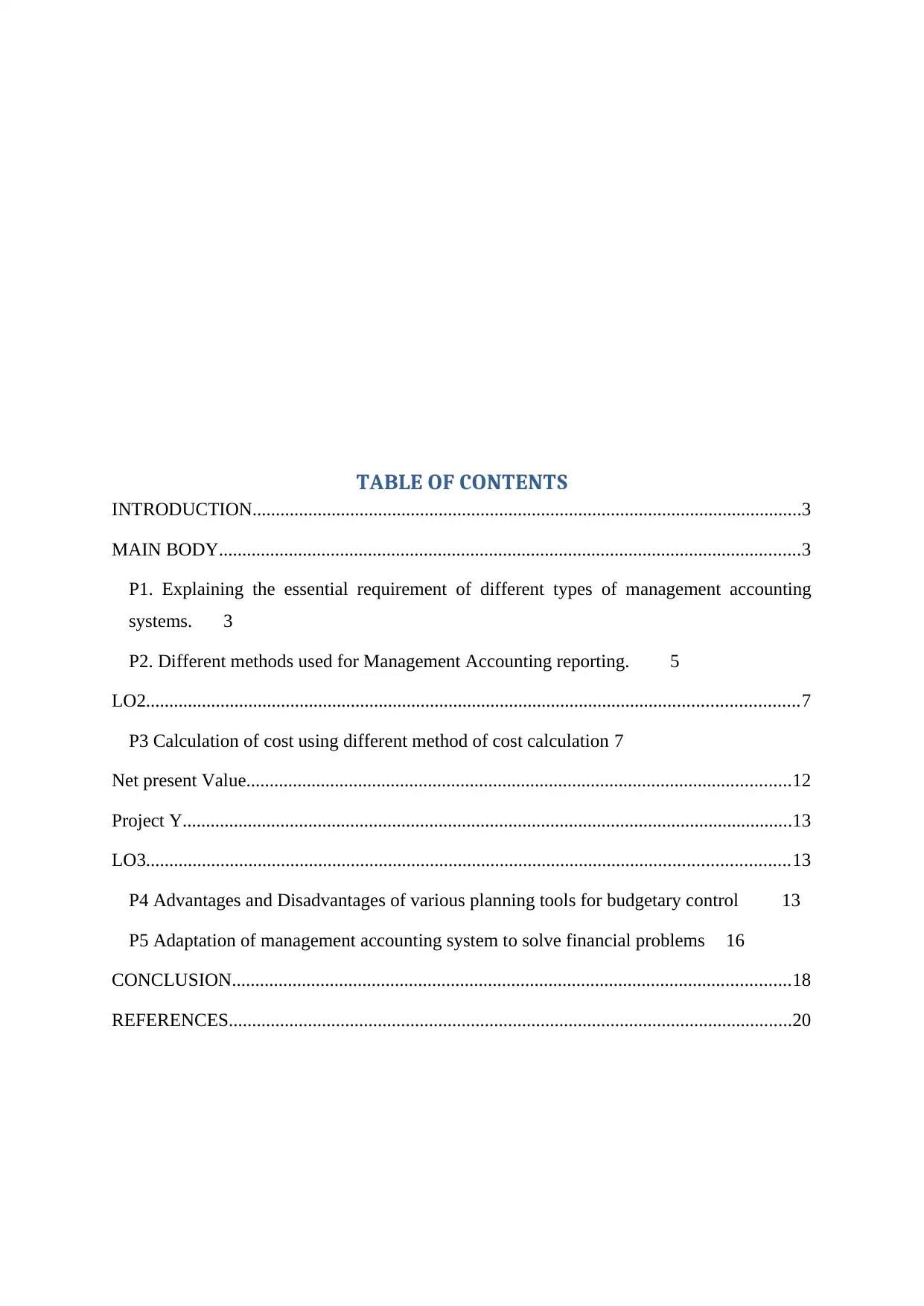
TABLE OF CONTENTS
INTRODUCTION......................................................................................................................3
MAIN BODY.............................................................................................................................3
P1. Explaining the essential requirement of different types of management accounting
systems. 3
P2. Different methods used for Management Accounting reporting. 5
LO2............................................................................................................................................7
P3 Calculation of cost using different method of cost calculation 7
Net present Value.....................................................................................................................12
Project Y...................................................................................................................................13
LO3..........................................................................................................................................13
P4 Advantages and Disadvantages of various planning tools for budgetary control 13
P5 Adaptation of management accounting system to solve financial problems 16
CONCLUSION........................................................................................................................18
REFERENCES.........................................................................................................................20
INTRODUCTION......................................................................................................................3
MAIN BODY.............................................................................................................................3
P1. Explaining the essential requirement of different types of management accounting
systems. 3
P2. Different methods used for Management Accounting reporting. 5
LO2............................................................................................................................................7
P3 Calculation of cost using different method of cost calculation 7
Net present Value.....................................................................................................................12
Project Y...................................................................................................................................13
LO3..........................................................................................................................................13
P4 Advantages and Disadvantages of various planning tools for budgetary control 13
P5 Adaptation of management accounting system to solve financial problems 16
CONCLUSION........................................................................................................................18
REFERENCES.........................................................................................................................20
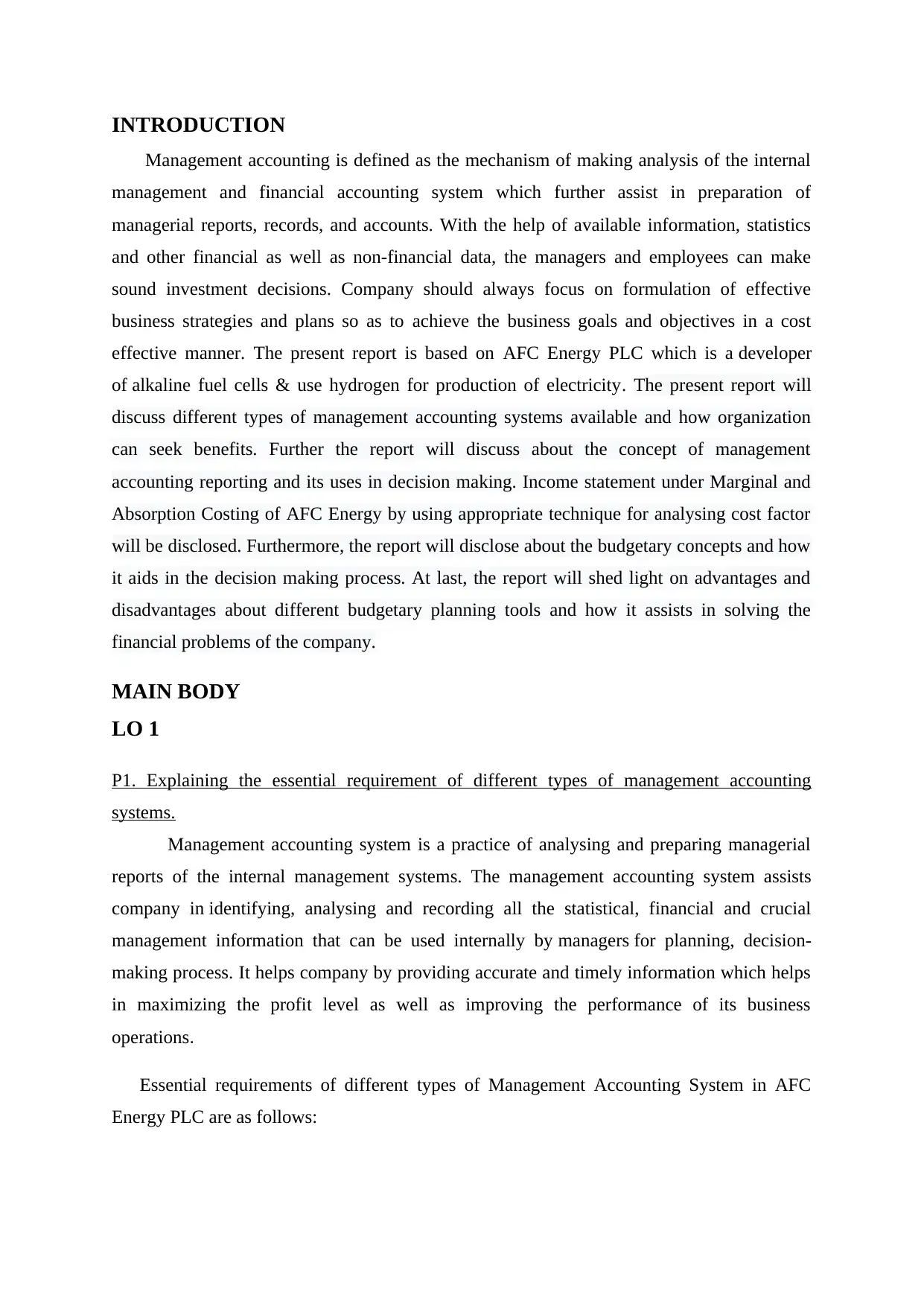
INTRODUCTION
Management accounting is defined as the mechanism of making analysis of the internal
management and financial accounting system which further assist in preparation of
managerial reports, records, and accounts. With the help of available information, statistics
and other financial as well as non-financial data, the managers and employees can make
sound investment decisions. Company should always focus on formulation of effective
business strategies and plans so as to achieve the business goals and objectives in a cost
effective manner. The present report is based on AFC Energy PLC which is a developer
of alkaline fuel cells & use hydrogen for production of electricity. The present report will
discuss different types of management accounting systems available and how organization
can seek benefits. Further the report will discuss about the concept of management
accounting reporting and its uses in decision making. Income statement under Marginal and
Absorption Costing of AFC Energy by using appropriate technique for analysing cost factor
will be disclosed. Furthermore, the report will disclose about the budgetary concepts and how
it aids in the decision making process. At last, the report will shed light on advantages and
disadvantages about different budgetary planning tools and how it assists in solving the
financial problems of the company.
MAIN BODY
LO 1
P1. Explaining the essential requirement of different types of management accounting
systems.
Management accounting system is a practice of analysing and preparing managerial
reports of the internal management systems. The management accounting system assists
company in identifying, analysing and recording all the statistical, financial and crucial
management information that can be used internally by managers for planning, decision-
making process. It helps company by providing accurate and timely information which helps
in maximizing the profit level as well as improving the performance of its business
operations.
Essential requirements of different types of Management Accounting System in AFC
Energy PLC are as follows:
Management accounting is defined as the mechanism of making analysis of the internal
management and financial accounting system which further assist in preparation of
managerial reports, records, and accounts. With the help of available information, statistics
and other financial as well as non-financial data, the managers and employees can make
sound investment decisions. Company should always focus on formulation of effective
business strategies and plans so as to achieve the business goals and objectives in a cost
effective manner. The present report is based on AFC Energy PLC which is a developer
of alkaline fuel cells & use hydrogen for production of electricity. The present report will
discuss different types of management accounting systems available and how organization
can seek benefits. Further the report will discuss about the concept of management
accounting reporting and its uses in decision making. Income statement under Marginal and
Absorption Costing of AFC Energy by using appropriate technique for analysing cost factor
will be disclosed. Furthermore, the report will disclose about the budgetary concepts and how
it aids in the decision making process. At last, the report will shed light on advantages and
disadvantages about different budgetary planning tools and how it assists in solving the
financial problems of the company.
MAIN BODY
LO 1
P1. Explaining the essential requirement of different types of management accounting
systems.
Management accounting system is a practice of analysing and preparing managerial
reports of the internal management systems. The management accounting system assists
company in identifying, analysing and recording all the statistical, financial and crucial
management information that can be used internally by managers for planning, decision-
making process. It helps company by providing accurate and timely information which helps
in maximizing the profit level as well as improving the performance of its business
operations.
Essential requirements of different types of Management Accounting System in AFC
Energy PLC are as follows:
⊘ This is a preview!⊘
Do you want full access?
Subscribe today to unlock all pages.

Trusted by 1+ million students worldwide
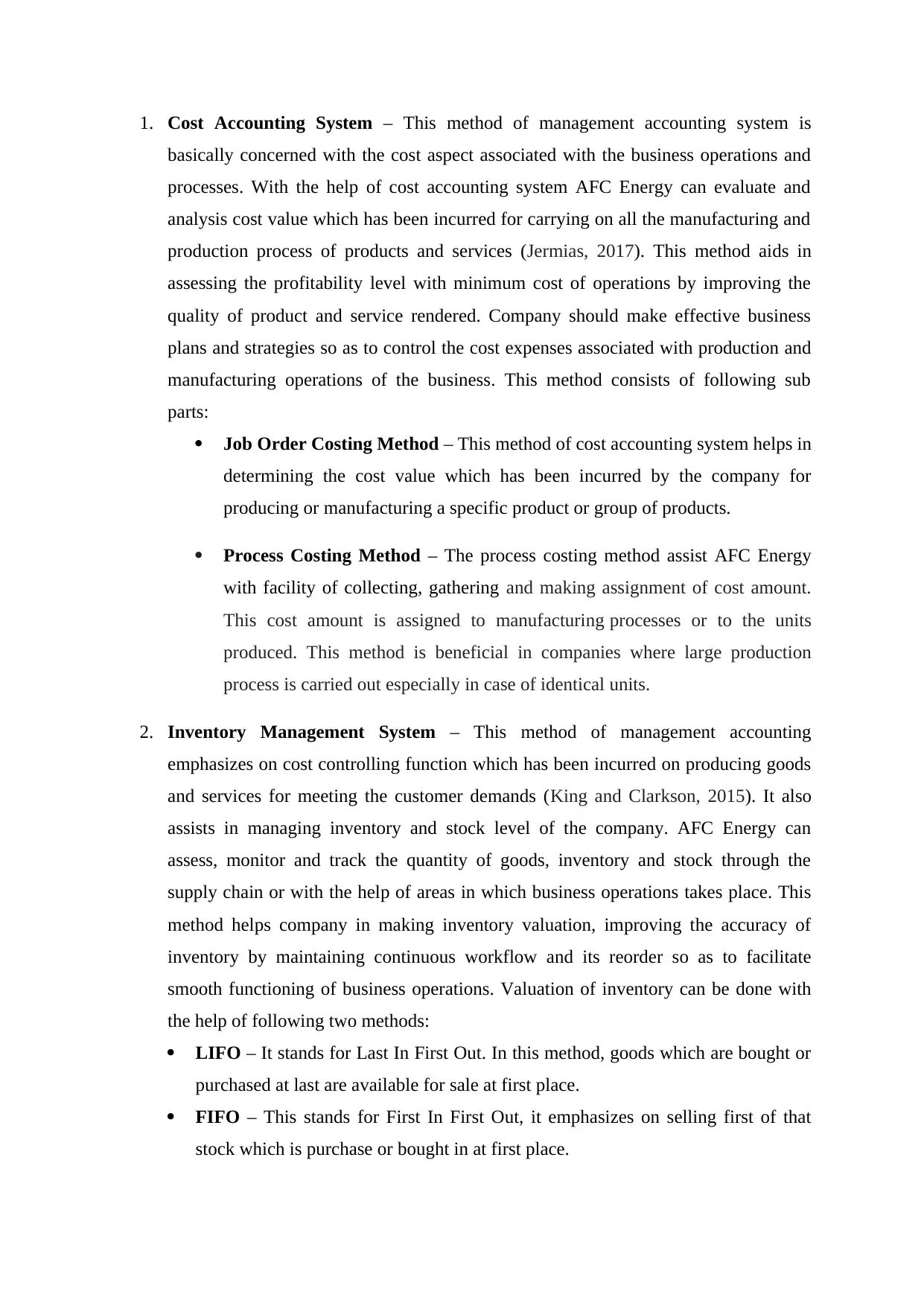
1. Cost Accounting System – This method of management accounting system is
basically concerned with the cost aspect associated with the business operations and
processes. With the help of cost accounting system AFC Energy can evaluate and
analysis cost value which has been incurred for carrying on all the manufacturing and
production process of products and services (Jermias, 2017). This method aids in
assessing the profitability level with minimum cost of operations by improving the
quality of product and service rendered. Company should make effective business
plans and strategies so as to control the cost expenses associated with production and
manufacturing operations of the business. This method consists of following sub
parts:
Job Order Costing Method – This method of cost accounting system helps in
determining the cost value which has been incurred by the company for
producing or manufacturing a specific product or group of products.
Process Costing Method – The process costing method assist AFC Energy
with facility of collecting, gathering and making assignment of cost amount.
This cost amount is assigned to manufacturing processes or to the units
produced. This method is beneficial in companies where large production
process is carried out especially in case of identical units.
2. Inventory Management System – This method of management accounting
emphasizes on cost controlling function which has been incurred on producing goods
and services for meeting the customer demands (King and Clarkson, 2015). It also
assists in managing inventory and stock level of the company. AFC Energy can
assess, monitor and track the quantity of goods, inventory and stock through the
supply chain or with the help of areas in which business operations takes place. This
method helps company in making inventory valuation, improving the accuracy of
inventory by maintaining continuous workflow and its reorder so as to facilitate
smooth functioning of business operations. Valuation of inventory can be done with
the help of following two methods:
LIFO – It stands for Last In First Out. In this method, goods which are bought or
purchased at last are available for sale at first place.
FIFO – This stands for First In First Out, it emphasizes on selling first of that
stock which is purchase or bought in at first place.
basically concerned with the cost aspect associated with the business operations and
processes. With the help of cost accounting system AFC Energy can evaluate and
analysis cost value which has been incurred for carrying on all the manufacturing and
production process of products and services (Jermias, 2017). This method aids in
assessing the profitability level with minimum cost of operations by improving the
quality of product and service rendered. Company should make effective business
plans and strategies so as to control the cost expenses associated with production and
manufacturing operations of the business. This method consists of following sub
parts:
Job Order Costing Method – This method of cost accounting system helps in
determining the cost value which has been incurred by the company for
producing or manufacturing a specific product or group of products.
Process Costing Method – The process costing method assist AFC Energy
with facility of collecting, gathering and making assignment of cost amount.
This cost amount is assigned to manufacturing processes or to the units
produced. This method is beneficial in companies where large production
process is carried out especially in case of identical units.
2. Inventory Management System – This method of management accounting
emphasizes on cost controlling function which has been incurred on producing goods
and services for meeting the customer demands (King and Clarkson, 2015). It also
assists in managing inventory and stock level of the company. AFC Energy can
assess, monitor and track the quantity of goods, inventory and stock through the
supply chain or with the help of areas in which business operations takes place. This
method helps company in making inventory valuation, improving the accuracy of
inventory by maintaining continuous workflow and its reorder so as to facilitate
smooth functioning of business operations. Valuation of inventory can be done with
the help of following two methods:
LIFO – It stands for Last In First Out. In this method, goods which are bought or
purchased at last are available for sale at first place.
FIFO – This stands for First In First Out, it emphasizes on selling first of that
stock which is purchase or bought in at first place.
Paraphrase This Document
Need a fresh take? Get an instant paraphrase of this document with our AI Paraphraser
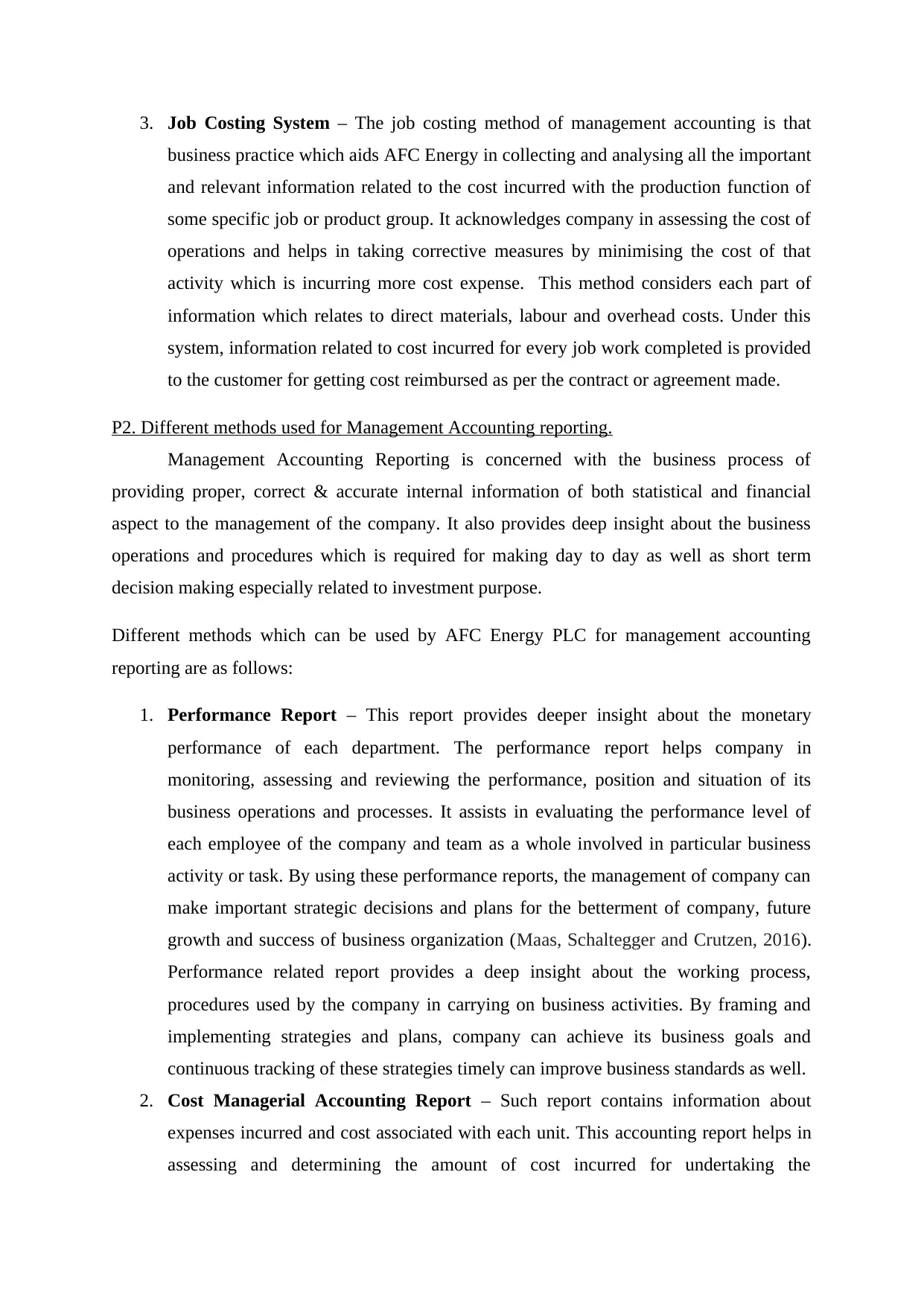
3. Job Costing System – The job costing method of management accounting is that
business practice which aids AFC Energy in collecting and analysing all the important
and relevant information related to the cost incurred with the production function of
some specific job or product group. It acknowledges company in assessing the cost of
operations and helps in taking corrective measures by minimising the cost of that
activity which is incurring more cost expense. This method considers each part of
information which relates to direct materials, labour and overhead costs. Under this
system, information related to cost incurred for every job work completed is provided
to the customer for getting cost reimbursed as per the contract or agreement made.
P2. Different methods used for Management Accounting reporting.
Management Accounting Reporting is concerned with the business process of
providing proper, correct & accurate internal information of both statistical and financial
aspect to the management of the company. It also provides deep insight about the business
operations and procedures which is required for making day to day as well as short term
decision making especially related to investment purpose.
Different methods which can be used by AFC Energy PLC for management accounting
reporting are as follows:
1. Performance Report – This report provides deeper insight about the monetary
performance of each department. The performance report helps company in
monitoring, assessing and reviewing the performance, position and situation of its
business operations and processes. It assists in evaluating the performance level of
each employee of the company and team as a whole involved in particular business
activity or task. By using these performance reports, the management of company can
make important strategic decisions and plans for the betterment of company, future
growth and success of business organization (Maas, Schaltegger and Crutzen, 2016).
Performance related report provides a deep insight about the working process,
procedures used by the company in carrying on business activities. By framing and
implementing strategies and plans, company can achieve its business goals and
continuous tracking of these strategies timely can improve business standards as well.
2. Cost Managerial Accounting Report – Such report contains information about
expenses incurred and cost associated with each unit. This accounting report helps in
assessing and determining the amount of cost incurred for undertaking the
business practice which aids AFC Energy in collecting and analysing all the important
and relevant information related to the cost incurred with the production function of
some specific job or product group. It acknowledges company in assessing the cost of
operations and helps in taking corrective measures by minimising the cost of that
activity which is incurring more cost expense. This method considers each part of
information which relates to direct materials, labour and overhead costs. Under this
system, information related to cost incurred for every job work completed is provided
to the customer for getting cost reimbursed as per the contract or agreement made.
P2. Different methods used for Management Accounting reporting.
Management Accounting Reporting is concerned with the business process of
providing proper, correct & accurate internal information of both statistical and financial
aspect to the management of the company. It also provides deep insight about the business
operations and procedures which is required for making day to day as well as short term
decision making especially related to investment purpose.
Different methods which can be used by AFC Energy PLC for management accounting
reporting are as follows:
1. Performance Report – This report provides deeper insight about the monetary
performance of each department. The performance report helps company in
monitoring, assessing and reviewing the performance, position and situation of its
business operations and processes. It assists in evaluating the performance level of
each employee of the company and team as a whole involved in particular business
activity or task. By using these performance reports, the management of company can
make important strategic decisions and plans for the betterment of company, future
growth and success of business organization (Maas, Schaltegger and Crutzen, 2016).
Performance related report provides a deep insight about the working process,
procedures used by the company in carrying on business activities. By framing and
implementing strategies and plans, company can achieve its business goals and
continuous tracking of these strategies timely can improve business standards as well.
2. Cost Managerial Accounting Report – Such report contains information about
expenses incurred and cost associated with each unit. This accounting report helps in
assessing and determining the amount of cost incurred for undertaking the
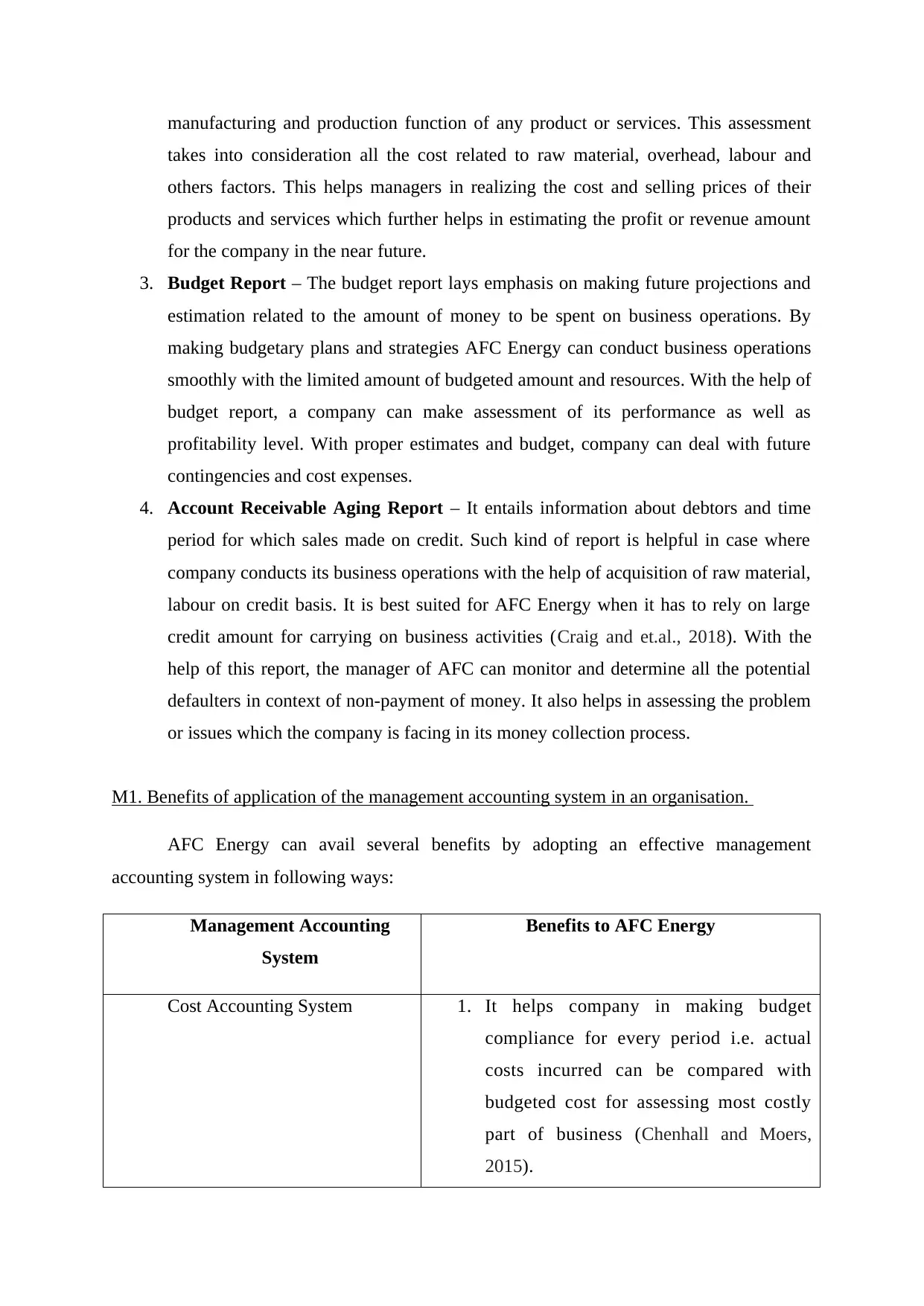
manufacturing and production function of any product or services. This assessment
takes into consideration all the cost related to raw material, overhead, labour and
others factors. This helps managers in realizing the cost and selling prices of their
products and services which further helps in estimating the profit or revenue amount
for the company in the near future.
3. Budget Report – The budget report lays emphasis on making future projections and
estimation related to the amount of money to be spent on business operations. By
making budgetary plans and strategies AFC Energy can conduct business operations
smoothly with the limited amount of budgeted amount and resources. With the help of
budget report, a company can make assessment of its performance as well as
profitability level. With proper estimates and budget, company can deal with future
contingencies and cost expenses.
4. Account Receivable Aging Report – It entails information about debtors and time
period for which sales made on credit. Such kind of report is helpful in case where
company conducts its business operations with the help of acquisition of raw material,
labour on credit basis. It is best suited for AFC Energy when it has to rely on large
credit amount for carrying on business activities (Craig and et.al., 2018). With the
help of this report, the manager of AFC can monitor and determine all the potential
defaulters in context of non-payment of money. It also helps in assessing the problem
or issues which the company is facing in its money collection process.
M1. Benefits of application of the management accounting system in an organisation.
AFC Energy can avail several benefits by adopting an effective management
accounting system in following ways:
Management Accounting
System
Benefits to AFC Energy
Cost Accounting System 1. It helps company in making budget
compliance for every period i.e. actual
costs incurred can be compared with
budgeted cost for assessing most costly
part of business (Chenhall and Moers,
2015).
takes into consideration all the cost related to raw material, overhead, labour and
others factors. This helps managers in realizing the cost and selling prices of their
products and services which further helps in estimating the profit or revenue amount
for the company in the near future.
3. Budget Report – The budget report lays emphasis on making future projections and
estimation related to the amount of money to be spent on business operations. By
making budgetary plans and strategies AFC Energy can conduct business operations
smoothly with the limited amount of budgeted amount and resources. With the help of
budget report, a company can make assessment of its performance as well as
profitability level. With proper estimates and budget, company can deal with future
contingencies and cost expenses.
4. Account Receivable Aging Report – It entails information about debtors and time
period for which sales made on credit. Such kind of report is helpful in case where
company conducts its business operations with the help of acquisition of raw material,
labour on credit basis. It is best suited for AFC Energy when it has to rely on large
credit amount for carrying on business activities (Craig and et.al., 2018). With the
help of this report, the manager of AFC can monitor and determine all the potential
defaulters in context of non-payment of money. It also helps in assessing the problem
or issues which the company is facing in its money collection process.
M1. Benefits of application of the management accounting system in an organisation.
AFC Energy can avail several benefits by adopting an effective management
accounting system in following ways:
Management Accounting
System
Benefits to AFC Energy
Cost Accounting System 1. It helps company in making budget
compliance for every period i.e. actual
costs incurred can be compared with
budgeted cost for assessing most costly
part of business (Chenhall and Moers,
2015).
⊘ This is a preview!⊘
Do you want full access?
Subscribe today to unlock all pages.

Trusted by 1+ million students worldwide
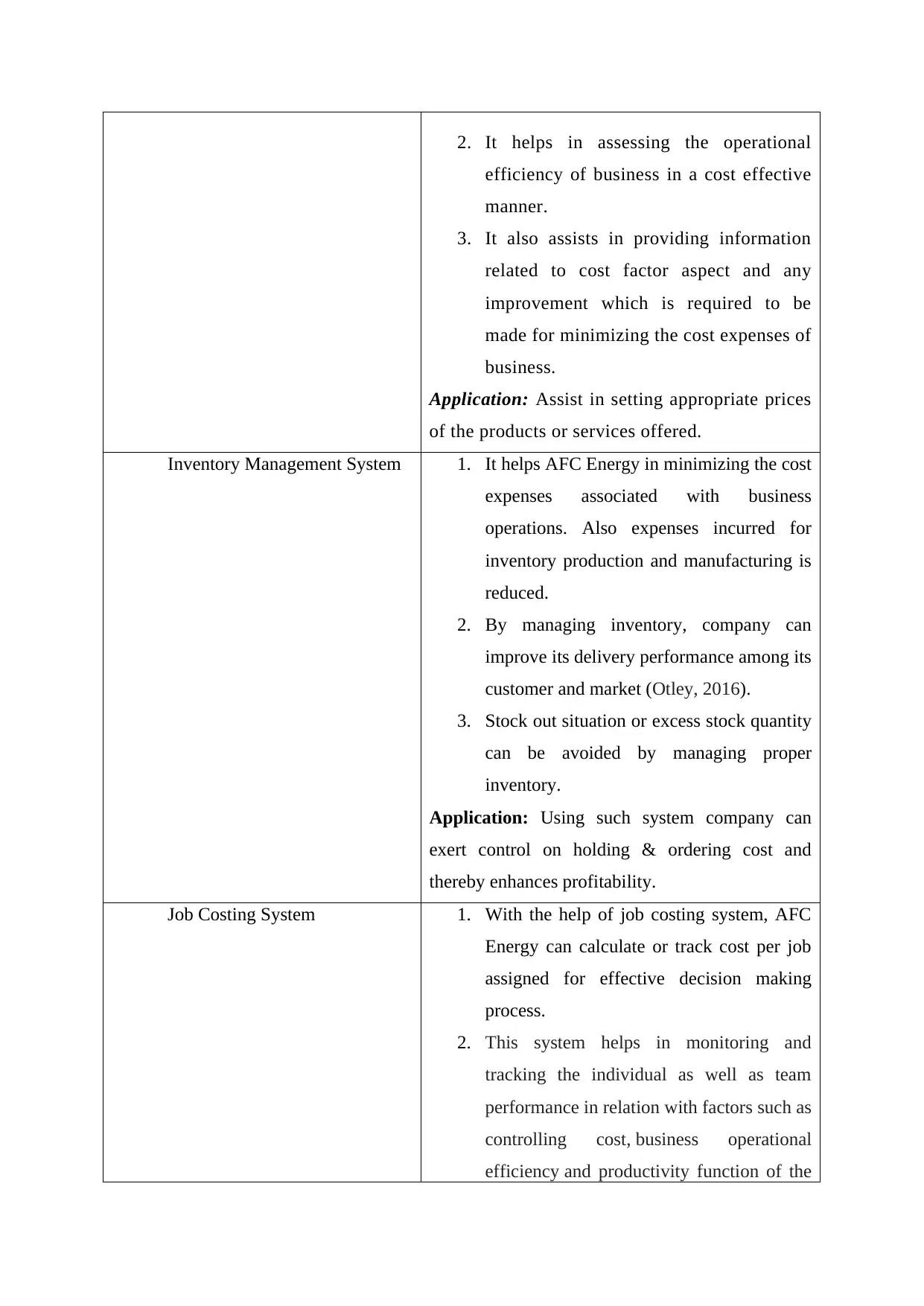
2. It helps in assessing the operational
efficiency of business in a cost effective
manner.
3. It also assists in providing information
related to cost factor aspect and any
improvement which is required to be
made for minimizing the cost expenses of
business.
Application: Assist in setting appropriate prices
of the products or services offered.
Inventory Management System 1. It helps AFC Energy in minimizing the cost
expenses associated with business
operations. Also expenses incurred for
inventory production and manufacturing is
reduced.
2. By managing inventory, company can
improve its delivery performance among its
customer and market (Otley, 2016).
3. Stock out situation or excess stock quantity
can be avoided by managing proper
inventory.
Application: Using such system company can
exert control on holding & ordering cost and
thereby enhances profitability.
Job Costing System 1. With the help of job costing system, AFC
Energy can calculate or track cost per job
assigned for effective decision making
process.
2. This system helps in monitoring and
tracking the individual as well as team
performance in relation with factors such as
controlling cost, business operational
efficiency and productivity function of the
efficiency of business in a cost effective
manner.
3. It also assists in providing information
related to cost factor aspect and any
improvement which is required to be
made for minimizing the cost expenses of
business.
Application: Assist in setting appropriate prices
of the products or services offered.
Inventory Management System 1. It helps AFC Energy in minimizing the cost
expenses associated with business
operations. Also expenses incurred for
inventory production and manufacturing is
reduced.
2. By managing inventory, company can
improve its delivery performance among its
customer and market (Otley, 2016).
3. Stock out situation or excess stock quantity
can be avoided by managing proper
inventory.
Application: Using such system company can
exert control on holding & ordering cost and
thereby enhances profitability.
Job Costing System 1. With the help of job costing system, AFC
Energy can calculate or track cost per job
assigned for effective decision making
process.
2. This system helps in monitoring and
tracking the individual as well as team
performance in relation with factors such as
controlling cost, business operational
efficiency and productivity function of the
Paraphrase This Document
Need a fresh take? Get an instant paraphrase of this document with our AI Paraphraser
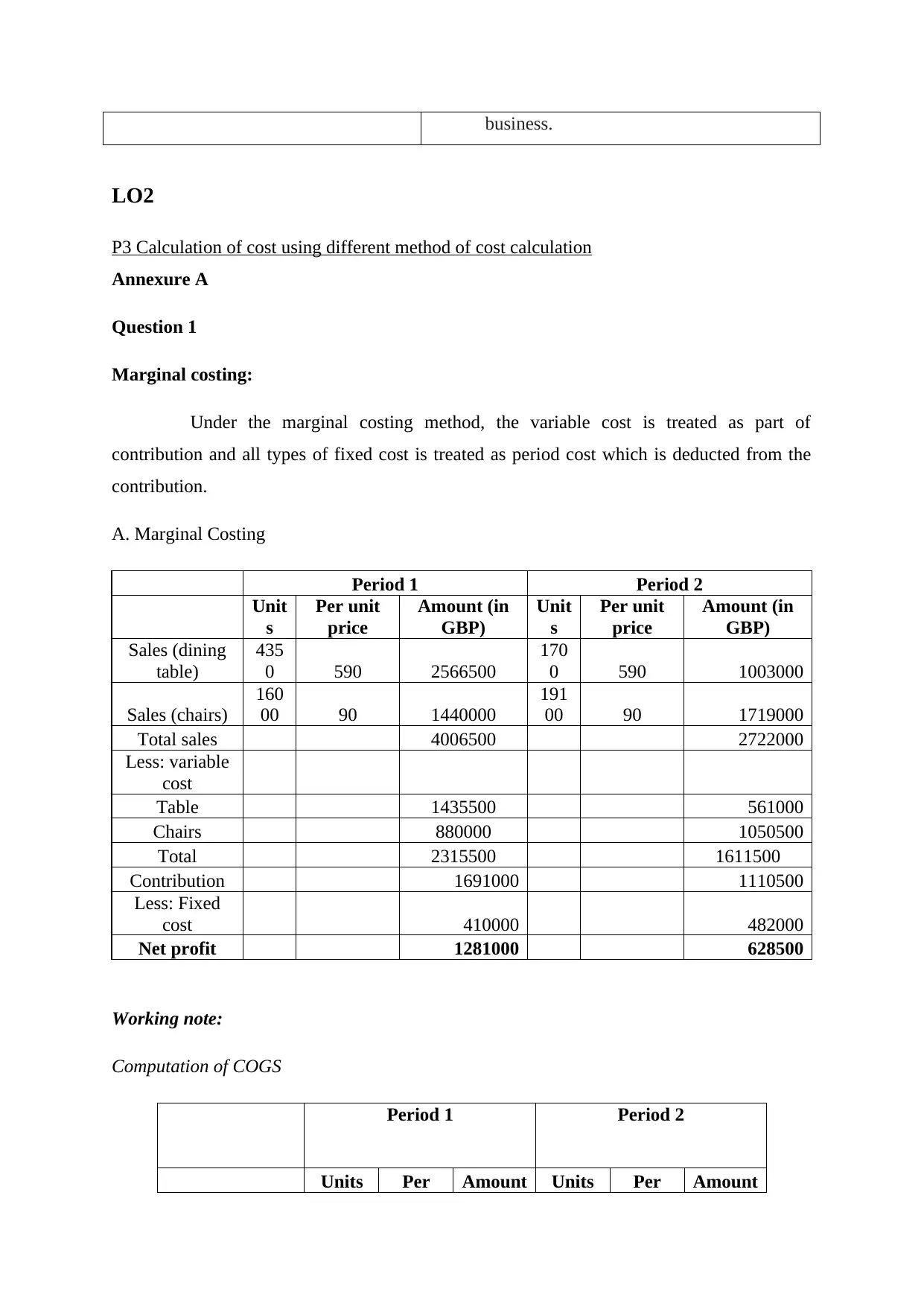
business.
LO2
P3 Calculation of cost using different method of cost calculation
Annexure A
Question 1
Marginal costing:
Under the marginal costing method, the variable cost is treated as part of
contribution and all types of fixed cost is treated as period cost which is deducted from the
contribution.
A. Marginal Costing
Period 1 Period 2
Unit
s
Per unit
price
Amount (in
GBP)
Unit
s
Per unit
price
Amount (in
GBP)
Sales (dining
table)
435
0 590 2566500
170
0 590 1003000
Sales (chairs)
160
00 90 1440000
191
00 90 1719000
Total sales 4006500 2722000
Less: variable
cost
Table 1435500 561000
Chairs 880000 1050500
Total 2315500 1611500
Contribution 1691000 1110500
Less: Fixed
cost 410000 482000
Net profit 1281000 628500
Working note:
Computation of COGS
Period 1 Period 2
Units Per Amount Units Per Amount
LO2
P3 Calculation of cost using different method of cost calculation
Annexure A
Question 1
Marginal costing:
Under the marginal costing method, the variable cost is treated as part of
contribution and all types of fixed cost is treated as period cost which is deducted from the
contribution.
A. Marginal Costing
Period 1 Period 2
Unit
s
Per unit
price
Amount (in
GBP)
Unit
s
Per unit
price
Amount (in
GBP)
Sales (dining
table)
435
0 590 2566500
170
0 590 1003000
Sales (chairs)
160
00 90 1440000
191
00 90 1719000
Total sales 4006500 2722000
Less: variable
cost
Table 1435500 561000
Chairs 880000 1050500
Total 2315500 1611500
Contribution 1691000 1110500
Less: Fixed
cost 410000 482000
Net profit 1281000 628500
Working note:
Computation of COGS
Period 1 Period 2
Units Per Amount Units Per Amount
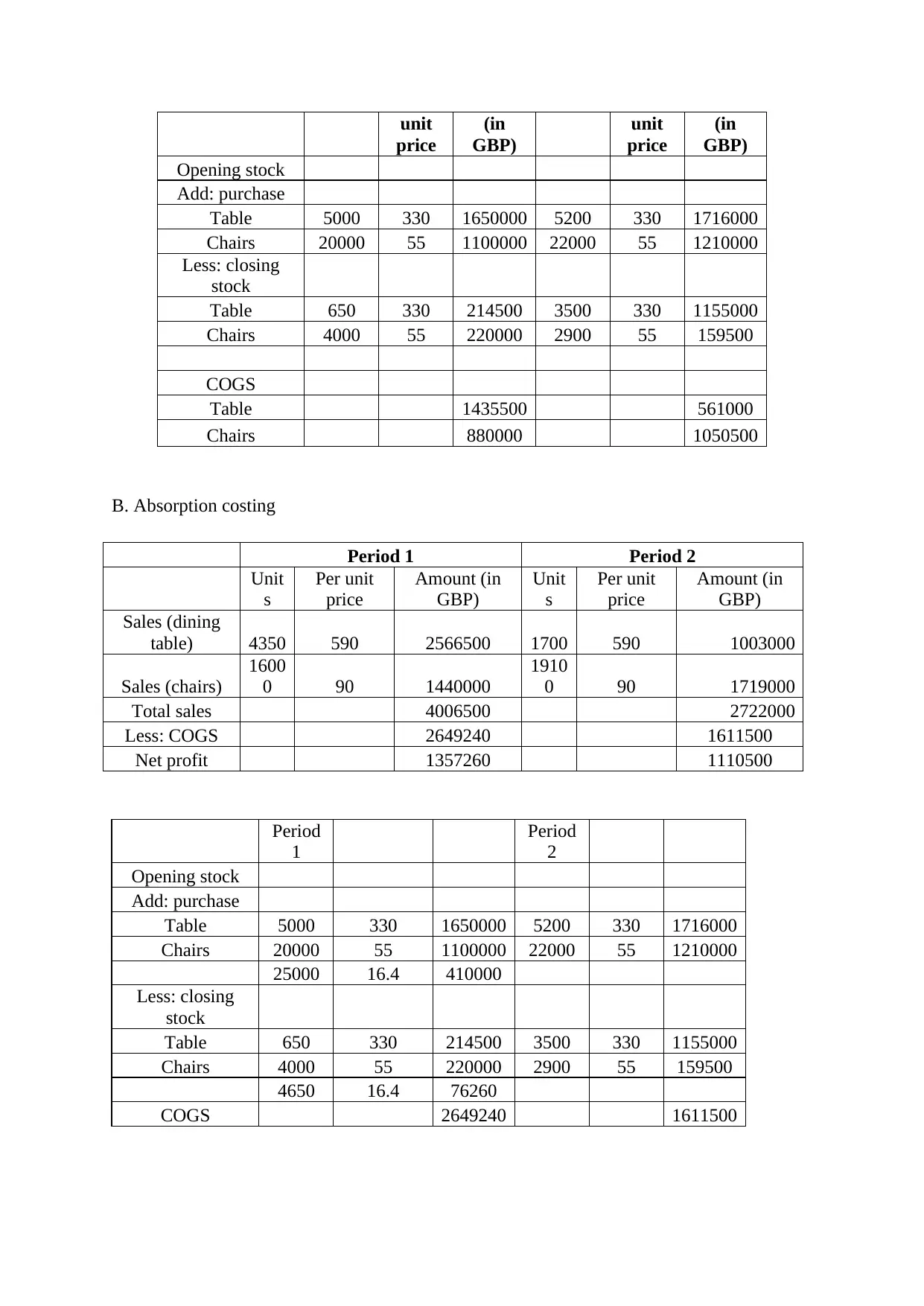
unit
price
(in
GBP)
unit
price
(in
GBP)
Opening stock
Add: purchase
Table 5000 330 1650000 5200 330 1716000
Chairs 20000 55 1100000 22000 55 1210000
Less: closing
stock
Table 650 330 214500 3500 330 1155000
Chairs 4000 55 220000 2900 55 159500
COGS
Table 1435500 561000
Chairs 880000 1050500
B. Absorption costing
Period 1 Period 2
Unit
s
Per unit
price
Amount (in
GBP)
Unit
s
Per unit
price
Amount (in
GBP)
Sales (dining
table) 4350 590 2566500 1700 590 1003000
Sales (chairs)
1600
0 90 1440000
1910
0 90 1719000
Total sales 4006500 2722000
Less: COGS 2649240 1611500
Net profit 1357260 1110500
Period
1
Period
2
Opening stock
Add: purchase
Table 5000 330 1650000 5200 330 1716000
Chairs 20000 55 1100000 22000 55 1210000
25000 16.4 410000
Less: closing
stock
Table 650 330 214500 3500 330 1155000
Chairs 4000 55 220000 2900 55 159500
4650 16.4 76260
COGS 2649240 1611500
price
(in
GBP)
unit
price
(in
GBP)
Opening stock
Add: purchase
Table 5000 330 1650000 5200 330 1716000
Chairs 20000 55 1100000 22000 55 1210000
Less: closing
stock
Table 650 330 214500 3500 330 1155000
Chairs 4000 55 220000 2900 55 159500
COGS
Table 1435500 561000
Chairs 880000 1050500
B. Absorption costing
Period 1 Period 2
Unit
s
Per unit
price
Amount (in
GBP)
Unit
s
Per unit
price
Amount (in
GBP)
Sales (dining
table) 4350 590 2566500 1700 590 1003000
Sales (chairs)
1600
0 90 1440000
1910
0 90 1719000
Total sales 4006500 2722000
Less: COGS 2649240 1611500
Net profit 1357260 1110500
Period
1
Period
2
Opening stock
Add: purchase
Table 5000 330 1650000 5200 330 1716000
Chairs 20000 55 1100000 22000 55 1210000
25000 16.4 410000
Less: closing
stock
Table 650 330 214500 3500 330 1155000
Chairs 4000 55 220000 2900 55 159500
4650 16.4 76260
COGS 2649240 1611500
⊘ This is a preview!⊘
Do you want full access?
Subscribe today to unlock all pages.

Trusted by 1+ million students worldwide
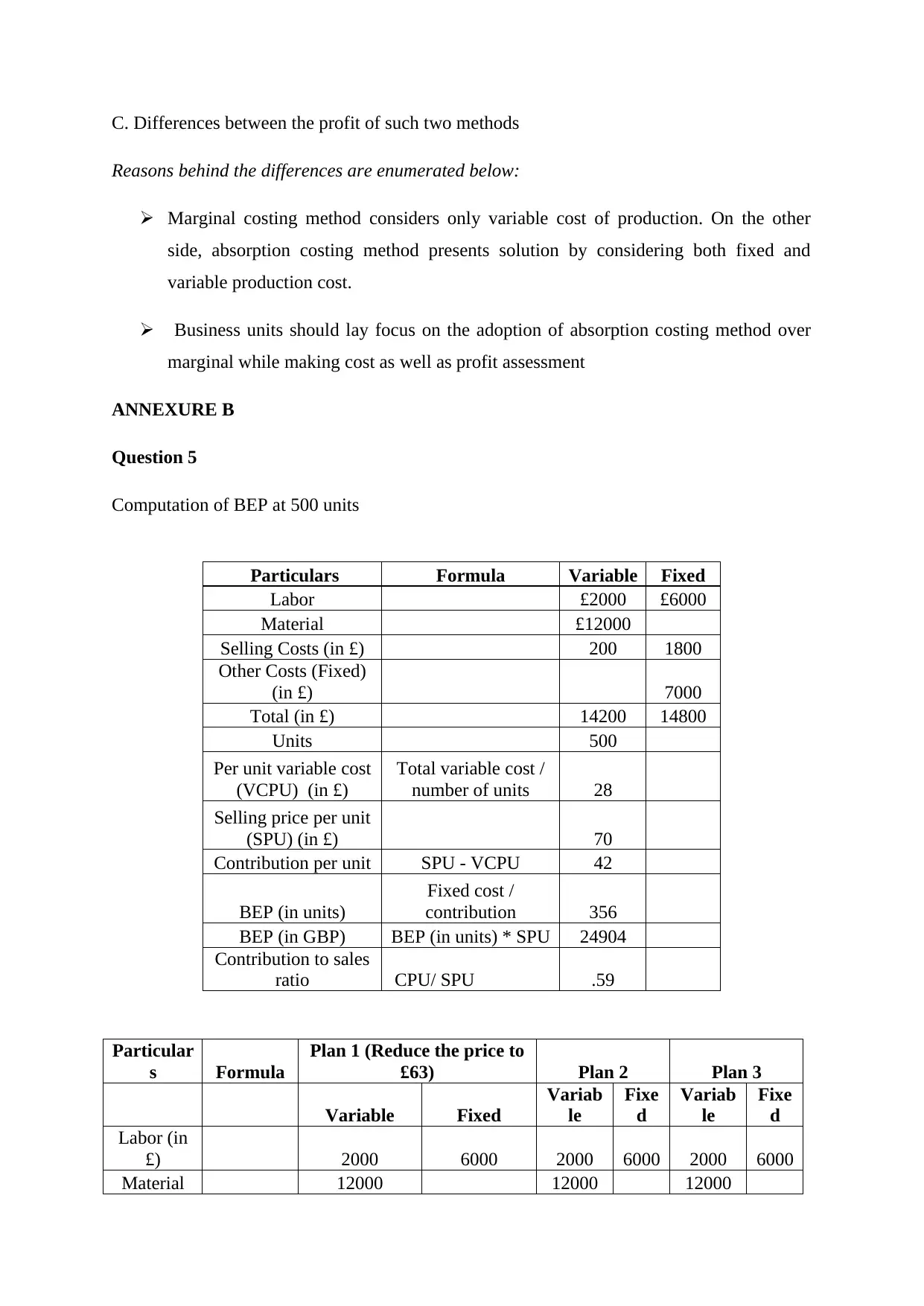
C. Differences between the profit of such two methods
Reasons behind the differences are enumerated below:
Marginal costing method considers only variable cost of production. On the other
side, absorption costing method presents solution by considering both fixed and
variable production cost.
Business units should lay focus on the adoption of absorption costing method over
marginal while making cost as well as profit assessment
ANNEXURE B
Question 5
Computation of BEP at 500 units
Particulars Formula Variable Fixed
Labor £2000 £6000
Material £12000
Selling Costs (in £) 200 1800
Other Costs (Fixed)
(in £) 7000
Total (in £) 14200 14800
Units 500
Per unit variable cost
(VCPU) (in £)
Total variable cost /
number of units 28
Selling price per unit
(SPU) (in £) 70
Contribution per unit SPU - VCPU 42
BEP (in units)
Fixed cost /
contribution 356
BEP (in GBP) BEP (in units) * SPU 24904
Contribution to sales
ratio CPU/ SPU .59
Particular
s Formula
Plan 1 (Reduce the price to
£63) Plan 2 Plan 3
Variable Fixed
Variab
le
Fixe
d
Variab
le
Fixe
d
Labor (in
£) 2000 6000 2000 6000 2000 6000
Material 12000 12000 12000
Reasons behind the differences are enumerated below:
Marginal costing method considers only variable cost of production. On the other
side, absorption costing method presents solution by considering both fixed and
variable production cost.
Business units should lay focus on the adoption of absorption costing method over
marginal while making cost as well as profit assessment
ANNEXURE B
Question 5
Computation of BEP at 500 units
Particulars Formula Variable Fixed
Labor £2000 £6000
Material £12000
Selling Costs (in £) 200 1800
Other Costs (Fixed)
(in £) 7000
Total (in £) 14200 14800
Units 500
Per unit variable cost
(VCPU) (in £)
Total variable cost /
number of units 28
Selling price per unit
(SPU) (in £) 70
Contribution per unit SPU - VCPU 42
BEP (in units)
Fixed cost /
contribution 356
BEP (in GBP) BEP (in units) * SPU 24904
Contribution to sales
ratio CPU/ SPU .59
Particular
s Formula
Plan 1 (Reduce the price to
£63) Plan 2 Plan 3
Variable Fixed
Variab
le
Fixe
d
Variab
le
Fixe
d
Labor (in
£) 2000 6000 2000 6000 2000 6000
Material 12000 12000 12000
Paraphrase This Document
Need a fresh take? Get an instant paraphrase of this document with our AI Paraphraser
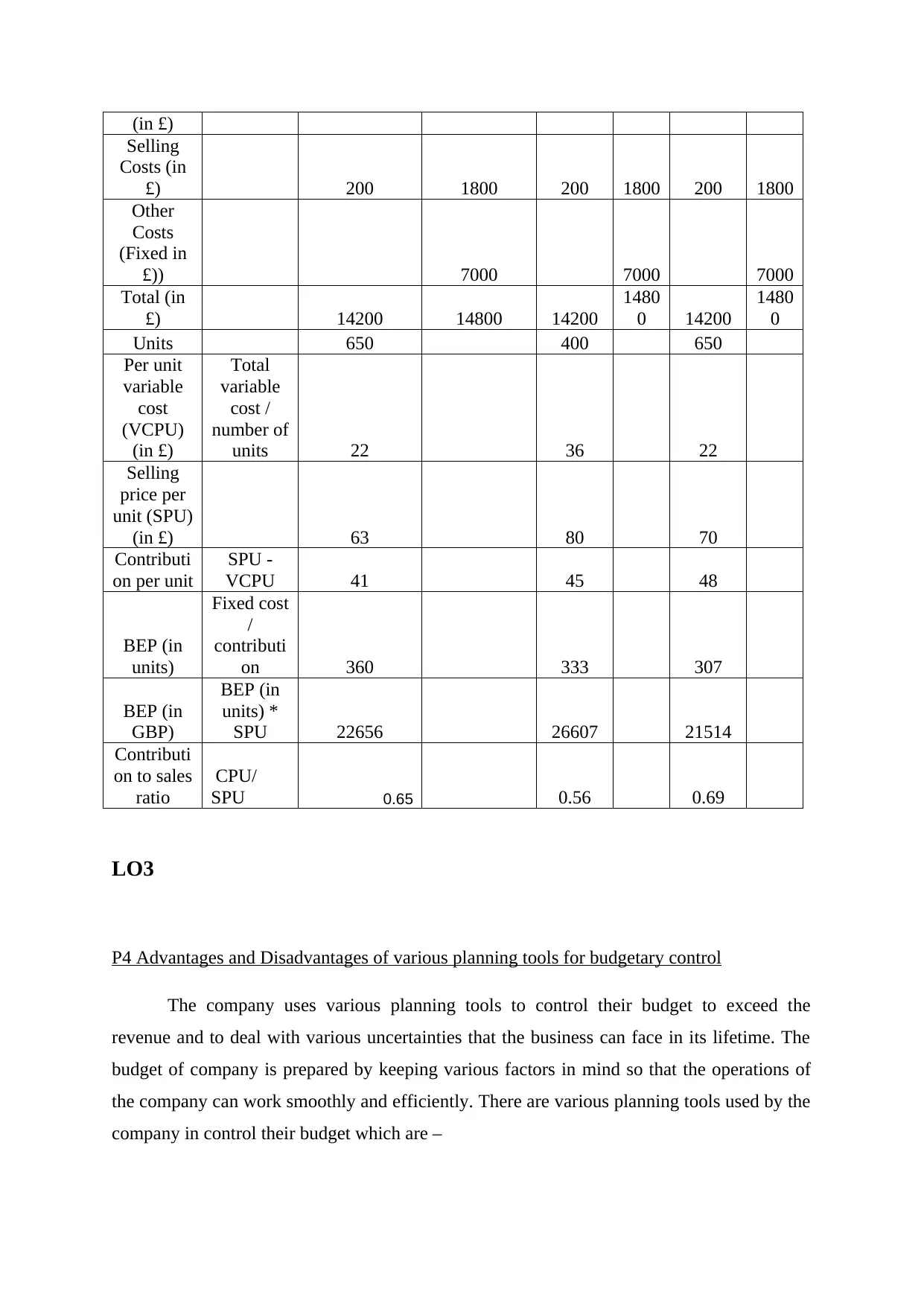
(in £)
Selling
Costs (in
£) 200 1800 200 1800 200 1800
Other
Costs
(Fixed in
£)) 7000 7000 7000
Total (in
£) 14200 14800 14200
1480
0 14200
1480
0
Units 650 400 650
Per unit
variable
cost
(VCPU)
(in £)
Total
variable
cost /
number of
units 22 36 22
Selling
price per
unit (SPU)
(in £) 63 80 70
Contributi
on per unit
SPU -
VCPU 41 45 48
BEP (in
units)
Fixed cost
/
contributi
on 360 333 307
BEP (in
GBP)
BEP (in
units) *
SPU 22656 26607 21514
Contributi
on to sales
ratio
CPU/
SPU 0.65 0.56 0.69
LO3
P4 Advantages and Disadvantages of various planning tools for budgetary control
The company uses various planning tools to control their budget to exceed the
revenue and to deal with various uncertainties that the business can face in its lifetime. The
budget of company is prepared by keeping various factors in mind so that the operations of
the company can work smoothly and efficiently. There are various planning tools used by the
company in control their budget which are –
Selling
Costs (in
£) 200 1800 200 1800 200 1800
Other
Costs
(Fixed in
£)) 7000 7000 7000
Total (in
£) 14200 14800 14200
1480
0 14200
1480
0
Units 650 400 650
Per unit
variable
cost
(VCPU)
(in £)
Total
variable
cost /
number of
units 22 36 22
Selling
price per
unit (SPU)
(in £) 63 80 70
Contributi
on per unit
SPU -
VCPU 41 45 48
BEP (in
units)
Fixed cost
/
contributi
on 360 333 307
BEP (in
GBP)
BEP (in
units) *
SPU 22656 26607 21514
Contributi
on to sales
ratio
CPU/
SPU 0.65 0.56 0.69
LO3
P4 Advantages and Disadvantages of various planning tools for budgetary control
The company uses various planning tools to control their budget to exceed the
revenue and to deal with various uncertainties that the business can face in its lifetime. The
budget of company is prepared by keeping various factors in mind so that the operations of
the company can work smoothly and efficiently. There are various planning tools used by the
company in control their budget which are –
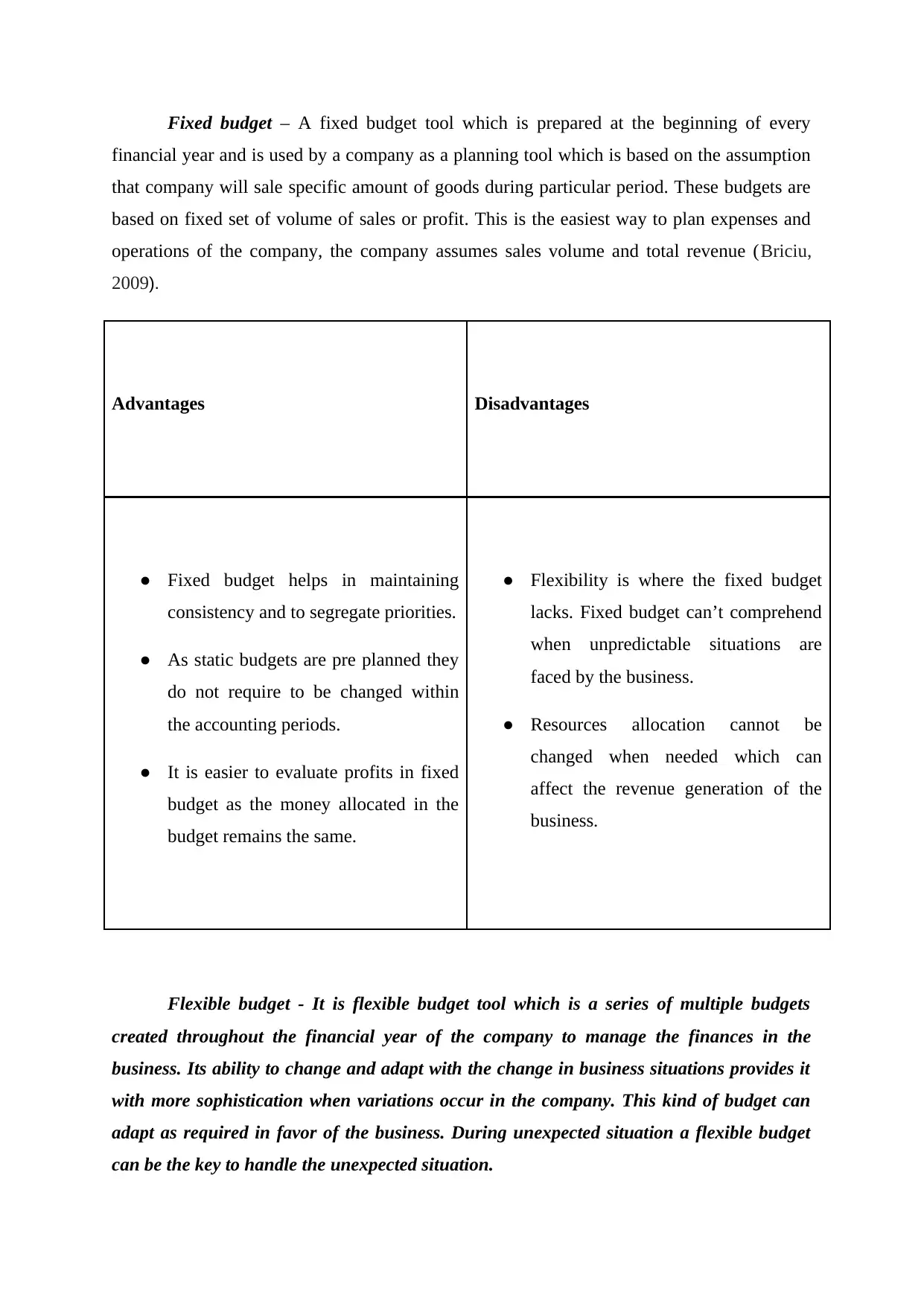
Fixed budget – A fixed budget tool which is prepared at the beginning of every
financial year and is used by a company as a planning tool which is based on the assumption
that company will sale specific amount of goods during particular period. These budgets are
based on fixed set of volume of sales or profit. This is the easiest way to plan expenses and
operations of the company, the company assumes sales volume and total revenue (Briciu,
2009).
Advantages Disadvantages
● Fixed budget helps in maintaining
consistency and to segregate priorities.
● As static budgets are pre planned they
do not require to be changed within
the accounting periods.
● It is easier to evaluate profits in fixed
budget as the money allocated in the
budget remains the same.
● Flexibility is where the fixed budget
lacks. Fixed budget can’t comprehend
when unpredictable situations are
faced by the business.
● Resources allocation cannot be
changed when needed which can
affect the revenue generation of the
business.
Flexible budget - It is flexible budget tool which is a series of multiple budgets
created throughout the financial year of the company to manage the finances in the
business. Its ability to change and adapt with the change in business situations provides it
with more sophistication when variations occur in the company. This kind of budget can
adapt as required in favor of the business. During unexpected situation a flexible budget
can be the key to handle the unexpected situation.
financial year and is used by a company as a planning tool which is based on the assumption
that company will sale specific amount of goods during particular period. These budgets are
based on fixed set of volume of sales or profit. This is the easiest way to plan expenses and
operations of the company, the company assumes sales volume and total revenue (Briciu,
2009).
Advantages Disadvantages
● Fixed budget helps in maintaining
consistency and to segregate priorities.
● As static budgets are pre planned they
do not require to be changed within
the accounting periods.
● It is easier to evaluate profits in fixed
budget as the money allocated in the
budget remains the same.
● Flexibility is where the fixed budget
lacks. Fixed budget can’t comprehend
when unpredictable situations are
faced by the business.
● Resources allocation cannot be
changed when needed which can
affect the revenue generation of the
business.
Flexible budget - It is flexible budget tool which is a series of multiple budgets
created throughout the financial year of the company to manage the finances in the
business. Its ability to change and adapt with the change in business situations provides it
with more sophistication when variations occur in the company. This kind of budget can
adapt as required in favor of the business. During unexpected situation a flexible budget
can be the key to handle the unexpected situation.
⊘ This is a preview!⊘
Do you want full access?
Subscribe today to unlock all pages.

Trusted by 1+ million students worldwide
1 out of 20
Related Documents
Your All-in-One AI-Powered Toolkit for Academic Success.
+13062052269
info@desklib.com
Available 24*7 on WhatsApp / Email
![[object Object]](/_next/static/media/star-bottom.7253800d.svg)
Unlock your academic potential
Copyright © 2020–2025 A2Z Services. All Rights Reserved. Developed and managed by ZUCOL.





